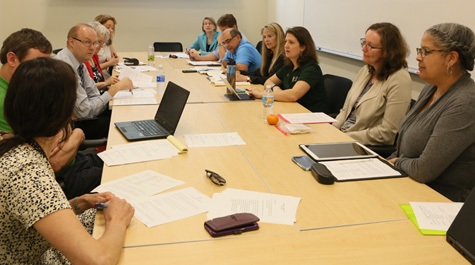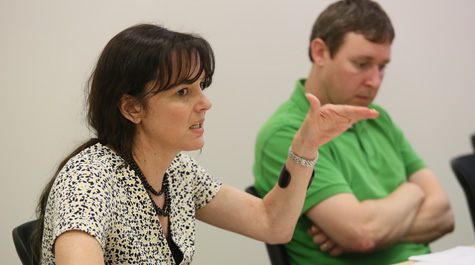Working group established to understand, address needs of people with disabilities
A group of faculty, administrators and students began work this semester to identify and address issues affecting people with disabilities on the William & Mary campus.
President Taylor Reveley formed the Disability Working Group in February, charging it with thinking beyond mere compliance with the Americans with Disabilities Act to more broadly meeting the needs of university community members “who deal daily with mobility, visual, hearing, neurological and other such impairments,” according to a February memo.
“We have the right people and are at the right point in time — with the president’s charge, this group is going to allow us to make a real push,” said Chief Compliance Officer and ADA Coordinator Kiersten Boyce, chair of the group.
Along with faculty and student representatives, the group of about 20 includes administrators who have expertise in relevant areas, such as accessibility services and facilities design and maintenance. At the end of the group’s first, hour-long meeting earlier this semester, its members didn’t want to leave, which Boyce saw as a great sign.
“This group of people, they are very passionate about this,” said group member Carla Costello, deputy ADA coordinator. “That’s one reason they didn’t want to leave; they just wanted to keep on talking and sharing not only their personal stories but, anonymously, stories of students and staff members and ways we can work on improving our campus.”
The president’s charge to the group was fairly open-ended without a specific list of deliverables, but he did emphasize identifying some “low-hanging fruit” that could be addressed in the near future.
“I’ve heard from students and faculty who have serious difficulty navigating William & Mary,” Reveley said. “It’s my hope that the Disability Working Group will identify steps we can quickly take to make our campus and programs more accessible. Larger projects requiring more resources also need to be identified and prioritized by the working group, even if we can’t take them in the near term.”
The group will be exploring issues related to physical disabilities, which can be particularly challenging on W&M’s historic campus. “Ancient beauty does not usually translate to the conveniences that modernity brings, which can be important,” said Boyce. However, the group’s purview includes all disabilities — both visible and invisible.
“The main thing to keep in mind that there are disabilities that are apparent, but there are also a lot of disabilities that aren’t,” Boyce said. “Disabilities can be neurological or even emotional.”
The work of the group will also take into consideration not only members of the campus community but all those who may visit it.
“For example, that includes everyone from a high school student who’s looking at W&M and has some kind of a condition to a staff member who becomes injured on the job and needs some kind of modification of their position, to a visitor, a parent or an alumnus who is coming to campus and has some sort of physical limitation, to a student who is involved in the online M.B.A. program and the accessibility of that — so there’s a lot that’s potentially there,” said Boyce.
The group, which has met three times now, is working to develop an initial list of actionable items, and Boyce expects that one of those will be increasing awareness among the campus community “of both what it’s like to have a disability and what it’s like to be on our campus with a disability.”
That awareness will hopefully encourage people across campus to take simple steps that will help increase accessibility at W&M, such as considering how written materials are produced or where meetings are held.
“In a lot of cases, making a building or program or event more accessible requires very minimal effort, if accessibility is considered from the outset,” said Boyce. “It requires awareness and sensitivity.”
The work of the group builds on efforts already happening across campus, such as the creation of the barrier reporting site, which people can use to report issues with physical, electronic or programmatic access. Reports made through that system, which is located on the accessibility website, are sent simultaneously to compliance, facilities management, diversity and inclusion and student accessibility services in order to be addressed in a timely fashion.
Boyce said that the establishment of the working group is important to the institution because the university is stronger as a whole when the community embraces all of its differences.
“Progress happens when we marry humility in the pursuit of knowledge, compassion for the differing paths taken by those in our midst and creativity in the application of solutions,” said Professor of Hispanic Studies Regina Root, a member of the working group.
“Let us be humble as we seek knowledge about those with disabilities. Let us be compassionate towards others as we learn about their paths. Let us be creative as we devise solutions for all in our campus community.”
 Skip to main content
Skip to main content


